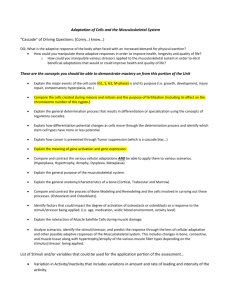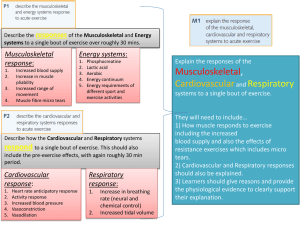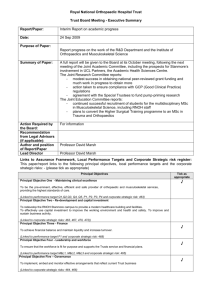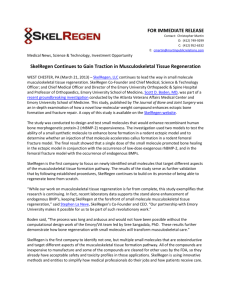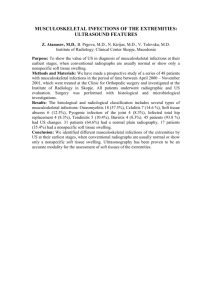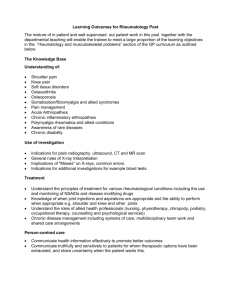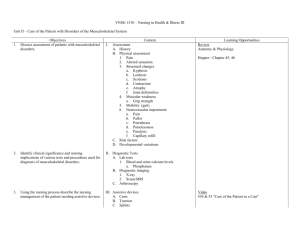Assessment of the Musculoskeletal System
advertisement
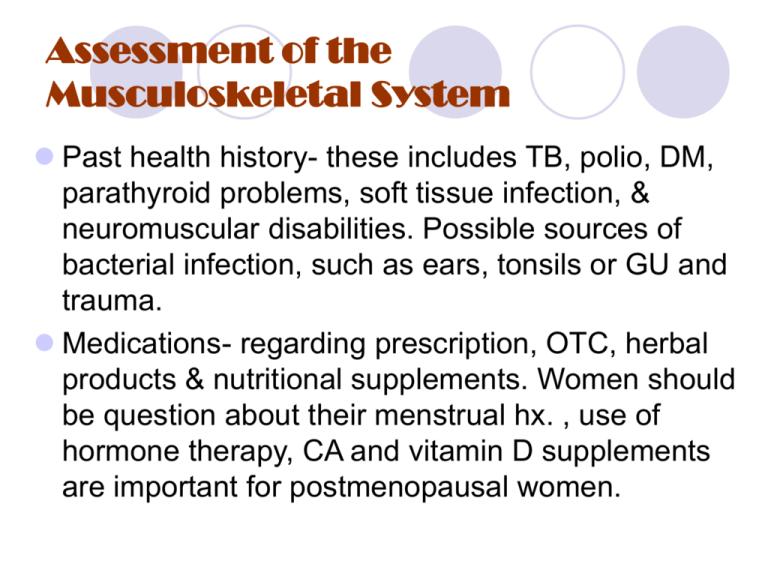
Assessment of the Musculoskeletal System Past health history- these includes TB, polio, DM, parathyroid problems, soft tissue infection, & neuromuscular disabilities. Possible sources of bacterial infection, such as ears, tonsils or GU and trauma. Medications- regarding prescription, OTC, herbal products & nutritional supplements. Women should be question about their menstrual hx. , use of hormone therapy, CA and vitamin D supplements are important for postmenopausal women. Assessment of the Musculoskeletal System Surgery or other treatments- past hospitalizations from musculoskeletal problems. Functional health patterns= Nutritional-metabolic pattern-dietary supplements. = Elimination= Activity-exercise-require assistance in completing ADL. = sleep-rest- difficulty sleeping. = Cognitive-perceptual-musculoskeletal pain Assessment of the Musculoskeletal System Functional Health patterns con’t….. = Self-perception-self-concept-changes in MS system-posture, walking,etc… = Role-relationship- live alone, effect on work. = Sexuality-reproductive-sexual concerns. = coping-stress tolerance- problems such as pain or immobility. = value-belief- cultural & religious practices. Assessment of the Musculoskeletal System Physical examination: * Inspection-use of an assistive devices such as walker. Observe general body build, muscle configuration, & symmetry of joint movement. Note for swelling, deformity, nodules or masses & discrepancies in limb length or muscle size. Assessment of the Musculoskeletal System Physical Examination con,t… * Palpation: of both muscles & joints allows for evaluation of skin temperature, local tenderness, swelling and crepitation. * Gait, motion of spine- smoothness, rhythm, limpimg, unsteady. Note height of shoulders, iliac crests, gluteal folds, shoulder & hip symmetry. Note for lumbar lordosis( concavity of the spine), kyphosis-(excessive curvature of thoracic spine), scoliosis (deviation to L or right) Assessment of the Musculoskeletal System Upper extremities- evaluate muscle strength. If joint motion compromised or painful-exam for fluid (effusion), increase temperature (inflammation). Passive movements elicits crunching noise (crepitus)-exam for nodules. Lower extremities- evaluate muscle action, ROM, pulses( femoral, tibial, dorsalis pedis).reflexes- (patellar, achilles, babinski) Assessment of the Musculoskeletal System Muscle Strength scale 0 No detection of muscular contraction 1 A barely detectable flicker or trace of contraction with observation or palpation. Active movement of body part with elimination of gravity. Active movement against gravity only and not against resistance 2 3 4 Active movement against gravity & some resistance 5 Active movement against full resistance without evident fatigue (Normal muscle strength) Assessment of the Musculoskeletal System Injured extremity- Observe for bleedingarterial (spurts), venous (steady), bones (oozes, oily). Pressure over main artery-if pressure at the site does’nt work. Check for deformities- if can’t move= need attention. Assessment of the Musculoskeletal System Diagnostic tests: X-ray- determine density of the bone. Arthrogram- visualization of joint structure & movement. Diskogram- vizualization of intervertebral disk abnormalitiy. Sinogram- visualizes course of sinus & tissues involved. CT- to identify soft tissue & bone abnormalities, and various MS trauma. MRI- to view soft tissue- useful in the dx. Of ligament tears, osteomyelitis, disk disease. Assessment of the Musculoskeletal System Bone Mineral Density (BMD) measurements: Dual energy x-ray absorptiometry (DEXA)- allows assessment of bone density with minimal radiation exposure- to monitor changes in bone density with treatment. Qualitative ultrasound (QUS)- evaluates density, elasticity & strength of patella & calcaneus using ultrasound rather than radiation. Assessment of the Musculoskeletal System Radioisotope Studies: Bone scan- injection of radioisotopes that is taken up by bone, then scan entire body for degree of uptake-related to blood flow. Increased uptake- osteoporosis, Ca of the bone, fractures. Decreased uptake-avascular necrosis. Assessment of the Musculoskeletal System Endoscopy: Arthroscopy- insertion of arthroscope into joint (usually knee) for visualization of structure and contents. It can be used for exploratory surgery (removal of loose bodies & biopsy) and dx. of abnormalities of meniscus, articular cartilage, ligaments, or joints capsule. Other structures that can be visualized include-shoulder, elbow, wrist, jaw, hip and ankle. Assessment of the Musculoskeletal System Invasive Procedures: Arthrocentesis- incision or puncture of joint capsule to obtain sample of synovial fluid from joint cavity or to remove excess fluid. Useful in dx. Of joint inflammation, infection, and subtle fractures. Electromyogram (EMG)- evaluates electrical potential associated with skeletal muscle contraction-useful in providing information related to lower motor neuron dysfunction and primary muscle disease. Assessment of the Musculoskeletal System Muscle enzymes- used to distinguish between muscle weakness that is due to nerve innervation problems and dystrophic disease of the muscle itself. The level of enzymes reflects the progress of the disorder and the effectiveness of treatment. ExampleCreatine kinase (CK),aldolase. Assessment of the Musculoskeletal System Serologic Studies: Rheumatoid factor(RF)- assess presence of autoantibody (RF) in serum. Erythrocyte sedimentation rate (ESR)index of inflammation. Antinuclear antibody (ANA)- assesses presence of antibodies capable of destroying nucleus of body’s tissue cells. Anti-DNA antibody- detects serum antibodies that react with DNA. It is the most specific test for systemic lupus erythematosus. Assessment of the Musculoskeletal System Mineral Metabolism: Alkaline phosphatase-produced by osteoblast of bone-needed for mineralization of organic bone matrix. Normal: 20 to 90 U/L (0.3 to 2,7 mmol/L). Calcium- bone primary organ for calcium storage. Normal: 9 to 11 mg/dl (2.3 to 2.7 mmol/L). Phosphorus- amount present indirectly related to calcium metabolism. Normal: 2.8 to 4.5 mg/dl (0.9 to 1,5 mmol/L) Assessment of the Musculoskeletal System Miscellaneous: Thermograpgy- uses infrared detector, which measures degree of heat radiating from skin surface. Useful in investigation of cause of inflamed joint and in following up pt.’s response to antiinflammatory drug therapy. Plethysmography- Study records variatios in volume & pressures of blood passing through tissues. Nosspecific. Somotosensory evoked potebtial (SSEP)evaluates evoked potential of muscle contractions. Help to identify neuropathy and myopathy.
